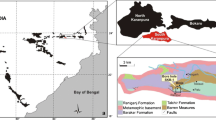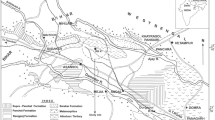Abstract
The Gondwana sediments comprising fine-grained shales, carbonaceous shales, sandstones and the coal horizon in borecore RT-4 (approximately 547.00m thick) from Tamra block, Raniganj Coalfield, Damodar Basin, are analyzed palynologically. Based on the distribution pattern of marker palynotaxa, two assemblage zones are identified. In the Barren Measures Formation, dominance of enveloping monosaccate (Densipollenites) along with striate bisaccate (Striatopodocarpites, Faunipollenites) pollen taxa, and the FAD’s of Kamthisaccites and Arcuatipollenites observed at 30.75, have equated this strata (30.75–227.80 m thick) with the Raniganj Formation of Late Permian in age. Downwards in the Barakar Formation, between 423.80–577.70 m depths, an abundance of non-striate (Scheuringipollenites) and striate (Faunipollenites and Striatopodocarpites) bisaccate pollen taxa is observed, that dates late Early Permian in age.
Fair occurrences of hyaline, distorted and blackish-brown plant matter is observed within 231.00–408.40 m depths. Present study infers the existence of the Raniganj Formation in the lithologically delimited Barren Measures Formation in the study area, and the underlying unproductive strata (approx. 177.40m) might represent the part of the Barren Measures Formation.
Similar content being viewed by others
References
Bharadwaj and Tiwari R S 1977 Permian-Triassic miofloras from the Raniganj Coalfield, India; Palaeobotanist 24 26–49.
Chandra S and Chandra A 1988 Vegitational changes and their climate implications in coal bearing Gondwana; In: Concepts limits and extension of Indian Gondwana (eds) Venkatachala B S and Maheshwari H K, Palaeobotanist 36 74–86.
Datta P K and Suttner L J 1986 Alluvial sandstone composition and palaeoclimate. II. Authigenic mineralogy; J. Sedim. Petrol. 56 346–358.
Gee E R 1932 The geology and coal resources of the Raniganj Coalfield; Geol. Surv. India Memoir 61 1–343.
Lele 1976 Palaeoclimate implications of Gondwana floras; Geophytology 6 207–229.
Shah S C 1976 Climates during Gondwana Era in Peninsular India: Faunal evidence; Geophytology 6 186–206.
Singh I B 1976 Mineralogical evidence for climate vicissitudes in India during Gondwana times; Geophytology 6 174–185.
Suttner L J and Datta P K 1986 Alluvial sandstone composition and palaeoclimate, 1. Frame work mineralogy; J. Sedim. Petrol. 56 329–345.
Tiwari R S 1973 Scheuringipollenites, a new name for the Gondwana sporomorphs so far assigned to Sulcatisporites Leschik 1955; Senckenb Letb. 54(1) 105–117.
Tiwari R S and Meena K L 1992 Palynological sequence and relationship of subsurface Permian-Triassic sediments in eastern Raniganj Coalfield, West Bengal, India; Geophytology 21 21–32.
Tiwari R S and Tripathi A 1988 Palynological zones and their climate inference in the coal bearing Gondwana of Peninsular India; Palaeobotanist 36 87–101.
Tiwari R S and Tripathi A 1992 Marker assemblage zones of spore and pollen species through Gondwana Paleozoic and Mesozoic sequence in India; Palaeobotanist 40 194–236.
Author information
Authors and Affiliations
Corresponding author
Rights and permissions
About this article
Cite this article
Murthy, S., Chakraborti, B. & Roy, M.D. Palynodating of subsurface sediments, Raniganj Coalfield, Damodar Basin, West Bengal. J Earth Syst Sci 119, 701–710 (2010). https://doi.org/10.1007/s12040-010-0049-y
Received:
Revised:
Accepted:
Published:
Issue Date:
DOI: https://doi.org/10.1007/s12040-010-0049-y




